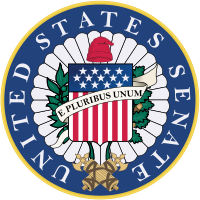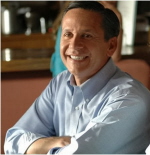Still thinking about running for the U.S. Senate? You’re Too Late
No non-incumbent has won a U.S. Senate seat by announcing their candidacy this late in the election cycle; the average length of successful U.S. Senate campaigns since 2000 has been 447 days

Republicans were particularly disappointed, considering Thompson had led Feingold in several polls conducted early this year in hypothetical matchups between two of the Badger State’s most well known political figures.
However, had Thompson run he would have attempted to do what no other non-incumbent has succeeded in doing this century: win a Senate seat after waiting until mid-April of the election year to launch a campaign.
A Smart Politics analysis of 166 general election contests conducted since 2000 finds that – with one unique exception – the latest a non-incumbent has announced their candidacy and gone on to win a U.S. Senate seat is April 3rd of the election year.
That distinction goes to Mark Dayton, former DFL Senator from Minnesota, who announced his candidacy on April 3, 2000, and holds the record over the past decade for the shortest period between such an announcement and Election Day – at 218 days.
The average length of a U.S. Senate campaign this decade for those who have successfully knocked off incumbents or won open seats has been 448 days (which would be August 11, 2009 in the current election cycle).
For open seat races, the average length of a successful campaign was 442 days while the average length of successful campaigns against incumbents was about two weeks longer at 454 days.
(Note: the ‘unique exception’ mentioned above deals with the 2002 New Jersey U.S. Senate race in which Democratic incumbent Robert Torricelli withdrew from the contest on September 30th after the disclosure of illegal contributions to his campaign. New Jersey Democrats then quickly picked former Senator Frank Lautenberg (who retired less than two years prior) to appear on the ballot in place of Torricelli – some 34 days before the election).
Mark Dayton is not the only candidate who announced and won a Senate seat in the year of the election.
After Dayton, other candidates who successfully flirted with the calendar are Democrat Ken Salazar of Colorado, who did not announce his candidacy until March 10th of 2004 (238 days out), Republican Lamar Alexander of Tennessee who waited until March 11th of 2002 (239 days out), and Republican Senator Tom Coburn of Oklahoma who announced on March 1st of 2004 (247 days out).
In the 2008 election cycle, all of the 10 general election non-incumbent winners announced their candidacies in 2007 with the exception of Alaska Democrat Mark Begich, who waited until February 27th of 2008 (251 days out).
The reasons why successful campaigns need more than 200 days to gestate are obvious – it takes time to raise the millions of dollars needed to win a U.S. Senate race, to build a statewide network of supporters, campaign volunteers, and endorsements, and to build name recognition, especially when running against incumbents.
But, despite the calendar nearly turning over to May, there are still names being floated about as potential U.S. Senate challengers in 2010.

Rossi’s entry in the race against three-term Democratic incumbent Patty Murray would likely squeeze out many of the nearly dozen announced Republican hopefuls vying to win their party’s primary this August.
However, with just 194 days to go before the general election, history would suggest Rossi has missed his opportunity to run and win.
Overall, of the 49 successful non-incumbents to win general election U.S. Senate seats since 2000, 13 launched their candidacies in the year of the election, 32 launched their candidacies in the year prior to the election, and four announced their candidacies two years prior to the election.
Republican Bob Corker of Tennessee is the ‘early bird’ winner – filing his paperwork in his bid to win outgoing Senator Bill Frist’s seat some 755 days before the 2006 election, on October 13, 2004.
Missouri Democrat Mel Carnahan was next by announcing his candidacy 734 days out from the 2000 Election, on November 4, 1998 (in a contest he won after dying in a plane crash three weeks before Election Day).
Republican George Allen of Virginia had the third longest campaign at 703 days – announcing his 2000 U.S. Senate bid on December 5, 1998.
Of course, some politicians play it ‘loose’ as to whether they are actually a true candidate for office, or just ‘exploring the possibility.’
For example, Democrat Hillary Clinton first filed papers with the FEC on July 7, 1999 prior to her ‘listening tour,’ but did not formally announce her bid for Senator from New York until February 6, 2000.
Similarly, Republican Norm Coleman of Minnesota formed a campaign committee on June 14, 2001, but did not announce his candidacy until February 11, 2002.
But whether or not a formal announcement accompanies the filing of paperwork, the lesson for those candidates still considering runs yet in 2010 is that if neither have been completed at this stage in the game, the game is likely over.
Length of Campaigns for Successful Non-Incumbent General Election U.S. Senate Candidates, 2000-2008
|
Senator
|
State
|
Party
|
Announced
|
Days
|
|
Frank Lautenberg*
|
NJ
|
Democrat
|
Oct. 2, 2002
|
34
|
|
Mark Dayton
|
MN
|
Democrat
|
Apr. 3, 2000
|
218
|
|
Ken Salazar
|
CO
|
Democrat
|
Mar. 10, 2004
|
238
|
|
Lamar Alexander
|
TN
|
Republican
|
Mar. 11, 2002
|
239
|
|
Tom Coburn
|
OK
|
Republican
|
Mar. 1, 2004
|
247
|
|
Mark Begich
|
AK
|
Democrat
|
Feb. 27, 2008
|
251
|
|
Ben Nelson
|
NE
|
Democrat
|
Feb. 24, 2000
|
257
|
|
Norm Coleman
|
MN
|
Republican
|
Feb. 11, 2002
|
267
|
|
Jim Webb
|
VA
|
Democrat
|
Feb. 7, 2006
|
273
|
|
Hillary Clinton
|
NY
|
Democrat
|
Feb. 6, 2000
|
275
|
|
Maria Cantwell
|
WA
|
Democrat
|
Jan. 19, 2000
|
293
|
|
Mel Martinez
|
FL
|
Republican
|
Jan. 5, 2004
|
302
|
|
John Thune
|
SD
|
Republican
|
Jan. 5, 2004
|
302
|
|
David Vitter
|
LA
|
Republican
|
Dec. 17, 2003
|
321
|
|
Tom Udall
|
NM
|
Democrat
|
Nov. 10, 2007
|
360
|
|
Kay Hagan
|
NC
|
Democrat
|
Oct. 30, 2007
|
371
|
|
Saxby Chambliss
|
GA
|
Republican
|
Oct. 16, 2001
|
385
|
|
John Sununu
|
NH
|
Republican
|
Oct. 15, 2001
|
386
|
|
Mike Johanns
|
NE
|
Republican
|
Oct. 10, 2007
|
391
|
|
Jim Risch
|
ID
|
Republican
|
Oct. 9, 2007
|
392
|
|
Sherrod Brown
|
OH
|
Democrat
|
Oct. 6, 2005
|
397
|
|
Elizabeth Dole
|
NC
|
Republican
|
Sep. 22, 2001
|
409
|
|
John Cornyn
|
TX
|
Republican
|
Sep. 21, 2001
|
410
|
|
John Corzine
|
NJ
|
Democrat
|
Sep. 23, 1999
|
411
|
|
Tom Carper
|
DE
|
Democrat
|
Sep. 21, 1999
|
413
|
|
Jeanne Shaheen
|
NH
|
Democrat
|
Sep. 14, 2007
|
417
|
|
Mark Warner
|
VA
|
Democrat
|
Sep. 13, 2007
|
418
|
|
Claire McCaskill
|
MO
|
Democrat
|
Aug. 30, 2005
|
434
|
|
Jeff Merkley
|
OR
|
Democrat
|
Aug. 1, 2007
|
461
|
|
Bernie Sanders
|
VT
|
Independent
|
Jul. 5, 2005
|
490
|
|
Jon Tester
|
MT
|
Democrat
|
May 24, 2005
|
532
|
|
Ben Cardin
|
MD
|
Democrat
|
Apr. 26, 2005
|
560
|
|
Mark Pryor
|
AR
|
Democrat
|
Apr. 23, 2001
|
561
|
|
Amy Klobuchar
|
MN
|
Democrat
|
Apr. 18, 2005
|
568
|
|
Mark Udall
|
CO
|
Democrat
|
Apr. 15, 2007
|
569
|
|
Sheldon Whitehouse
|
RI
|
Democrat
|
Apr. 4, 2005
|
582
|
|
Debbie Stabenow
|
MI
|
Democrat
|
Mar. 29, 1999
|
589
|
|
Bill Nelson
|
FL
|
Democrat
|
Mar. 18, 1999
|
600
|
|
Bob Casey
|
PA
|
Democrat
|
Mar. 4, 2005
|
613
|
|
Lindsey Graham
|
SC
|
Republican
|
Feb. 21, 2001
|
622
|
|
John Ensign
|
NV
|
Republican
|
Feb. 19, 1999
|
627
|
|
Al Franken
|
MN
|
Democrat
|
Feb. 14, 2007
|
629
|
|
Richard Burr
|
NC
|
Republican
|
Feb. 10, 2003
|
631
|
|
Barack Obama
|
IL
|
Democrat
|
Jan. 21, 2003
|
651
|
|
Johnny Isakson
|
GA
|
Republican
|
Jan. 15, 2003
|
657
|
|
Jim DeMint
|
SC
|
Republican
|
Dec. 16, 2002
|
687
|
|
George Allen
|
VA
|
Republican
|
Dec. 5, 1998
|
703
|
|
Mel Carnahan**
|
MO
|
Democrat
|
Nov. 4, 1998
|
734
|
|
Bob Corker
|
TN
|
Republican
|
Oct. 13, 2004
|
755
|
|
Average
|
|
|
|
448
|
* Frank Lautenberg was added at the 11th hour to the New Jersey ballot when the Democratic Party had to fill the slot after incumbent Robert Torricelli withdrew from the race. ** Mel Carnahan received the most votes on Election Day after dying on October 17, 2000 in a plane crash. His wife Jeanne was appointed to the seat. Data compiled by Smart Politics.
Follow Smart Politics on Twitter.
